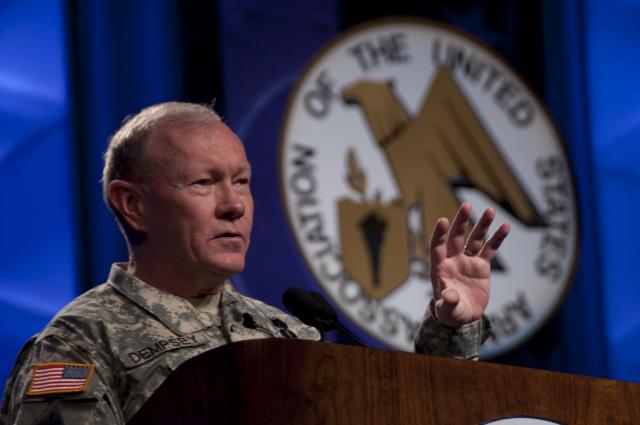The nation’s top military officer wrote in a blog post yesterday about a new Defense Department concept to assure U.S. forces entry and sustained access to any contested domain: land, air, space, sea or cyber.
Army Gen. Martin E. Dempsey, chairman of the Joint Chiefs of Staff, said the Joint Operational Access Concept is based on the defense strategic guidance President Barack Obama and Defense Secretary Leon E. Panetta released this month.
“No matter how formidable our forces, if we are unable to bring our capabilities to bear in any of these domains, we may not be able to complete the mission or meet our nation’s needs,” the chairman wrote. “Our adversaries know this as well.”
For the Army, Navy, Air Force and Marine Corps of the future, Dempsey wrote, gaining access to the right place at the right time presents an ever more pressing challenge.
“The [concept] outlines how we will confront emerging anti-access/area denial [referred to by military members as A2/AD] threats by state and non-state enemies across the globe,” the chairman noted in his blog. “A2/AD is not new, but it is a defining characteristic of today’s operational environment.”
In a foreword to the concept document, Dempsey noted that each service helped to develop the approach and each has a vital role to play, separately and together, in carrying it out.
“Embracing cross-domain synergy at increasingly lower levels will be essential to generating the tempo that is often critical to exploiting fleeting local opportunities for disrupting the enemy system,” Dempsey wrote in the foreword. “The [concept] also envisions a greater degree and more flexible integration of space and cyberspace operations into the traditional air-sea-land battlespace than ever before.”
The 64-page document setting forth the concept outlines both A2/AD threats and effective means to countering them. Anti-access threats usually are long-range, employed most often against air and sea approaches, and designed to prevent an opposing force from entering an operational area. Area denial refers to shorter-range actions and capabilities, designed to limit an opposing force’s freedom of action within all domains of the operational area.
The document lists key anti-access capabilities U.S. forces may face as ballistic and cruise missiles, long-range reconnaissance and surveillance systems, anti-satellite weapons, submarines, cyber and terrorist attacks and special operations forces.
Area denial capabilities, according to the concept, include air forces and air defense systems; short-range missiles and submarine-based torpedoes; precision-guided rockets, artillery, missiles and mortars; chemical and biological weapons; computer and electronic attacks; land- and sea-based mines; unmanned surveillance or weapons systems; land forces; and special operations forces.
According to the concept document, countering these capabilities requires preparing the operational area in advance, seizing the initiative with multiple deployments and operations, exploiting advantages in one domain to disrupt or destroy enemy capabilities in others, and protecting space and cyber assets while attacking the enemy’s.
“The concept identifies 30 operational capabilities the future joint force will need to gain operational access in an opposed environment,” the document reads, in part. “The implications of creating and maintaining these capabilities in the necessary capacity are potentially profound.”
The concept’s authors acknowledge risks with the approach. It could lead to operations that are logistically or economically unsupportable or of “debilitating complexity,” the document states.
Even in successful operations, the authors note, “gaining and maintaining operational access in the face of armed resistance is inherently fraught with risk.”
The chairman’s blog post emphasized the nation’s military faces a clear strategic challenge: it must maintain the freedom of action to accomplish any assigned mission.
“The Joint Operational Access Concept is a critical first step in ensuring the joint force has the requisite capabilities to do so,” he concluded.









